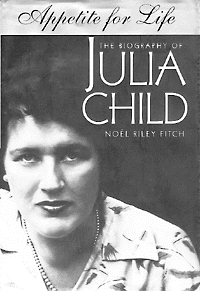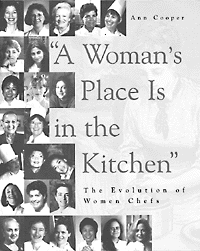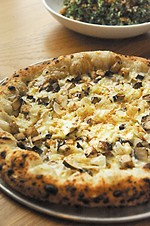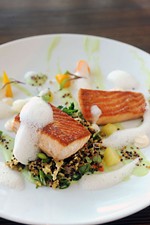Be Like Julia
Inspiring Tales of Ms. Child and Other Women in Kitchens
By Virginia B. Wood, Fri., Dec. 26, 1997
 The conclusion of one year and the rapidly ensuing birth of another puts me in a mood that is both reflective and anticipatory. When I began writing several years ago, I gave myself 10 years to develop a career in which writing would provide financial support and I could cook for recreation rather than profit. This is the time of year when I re-evaluate my progress and plan for the future. Seven and a half years into the deal, I've encountered two new books that detail the great changes for women in the professional cooking field and reminded me who and what inspired my career choice in the first place. A Woman's Place Is in the Kitchen (VanNostrand Reinhold, $21.95 paper) by chef Ann Cooper and Noel Riley Fitch's elegant biography of American cultural icon Julia Child, entitled Appetite for Life (Doubleday, $35.95 hard), are must-read titles for any woman (or man) currently working in the food field or considering a cooking career. As a chubby child in the Fifties and Sixties, I was not encouraged to enjoy food or spend time in the kitchen, and the alluring soda fountain at my father's downtown drugstore was pretty much off-limits. Unfortunately, my parent's concern for my weight made food the family battleground. It wasn't until I was a teenager and surreptitiously watched a large, trumpet-voiced woman named Julia Child demonstrating French cooking techniques on public television that I realized people actually had fun in the kitchen. At that point, Julia appealed to me because she was an unconventional size (so was I) and had a wonderful sense of humor about food. But she also opened my eyes to the satisfying sensual possibilities of cooking, as she did for thousands of other aspiring cooks. Not long after I discovered Julia, I had my first restaurant job. During the summers after my freshman and sophomore years of college, I worked as a hotel maid and waitress at a resort hotel in a Montana national park. Even though there were no women in the kitchen to serve as role models and the chef was a recovering alcoholic who threw kitchen utensils at hapless waiters who broke the taboo against whistling in his kitchen, I was totally smitten with restaurant work. The die was cast.
The conclusion of one year and the rapidly ensuing birth of another puts me in a mood that is both reflective and anticipatory. When I began writing several years ago, I gave myself 10 years to develop a career in which writing would provide financial support and I could cook for recreation rather than profit. This is the time of year when I re-evaluate my progress and plan for the future. Seven and a half years into the deal, I've encountered two new books that detail the great changes for women in the professional cooking field and reminded me who and what inspired my career choice in the first place. A Woman's Place Is in the Kitchen (VanNostrand Reinhold, $21.95 paper) by chef Ann Cooper and Noel Riley Fitch's elegant biography of American cultural icon Julia Child, entitled Appetite for Life (Doubleday, $35.95 hard), are must-read titles for any woman (or man) currently working in the food field or considering a cooking career. As a chubby child in the Fifties and Sixties, I was not encouraged to enjoy food or spend time in the kitchen, and the alluring soda fountain at my father's downtown drugstore was pretty much off-limits. Unfortunately, my parent's concern for my weight made food the family battleground. It wasn't until I was a teenager and surreptitiously watched a large, trumpet-voiced woman named Julia Child demonstrating French cooking techniques on public television that I realized people actually had fun in the kitchen. At that point, Julia appealed to me because she was an unconventional size (so was I) and had a wonderful sense of humor about food. But she also opened my eyes to the satisfying sensual possibilities of cooking, as she did for thousands of other aspiring cooks. Not long after I discovered Julia, I had my first restaurant job. During the summers after my freshman and sophomore years of college, I worked as a hotel maid and waitress at a resort hotel in a Montana national park. Even though there were no women in the kitchen to serve as role models and the chef was a recovering alcoholic who threw kitchen utensils at hapless waiters who broke the taboo against whistling in his kitchen, I was totally smitten with restaurant work. The die was cast.
While I was following my own winding path into the food business during the Seventies, women around the country were beginning to show up in cooking schools and professional kitchens. Though the percentages of women working in professional kitchens was small in that decade, the tide began to turn. By the time I worked in another resort kitchen in 1979, I was one of five women in a 60-person kitchen staff. The Eighties saw an explosion in the restaurant field, with professional culinary schools blossoming in all parts of the country and women beginning to assume positions of authority in some of the best restaurant and hotel kitchens around. Chef Ann Cooper's well-researched book traces the evolution of women chefs in America and provides the reader with tremendous insight into the serious sacrifices and rich rewards that accompany a professional cooking career. Cooper interviewed women chefs around the country (curiously, none in Texas) and uses their career histories and anecdotes to bring her statistical research to life. It's somehow very reaffirming to read that female celebrity chefs and restaurateurs have the same difficulties as those of us unknowns in the trenches. Many times during the reading of the book, I had the experience of thinking, "That's just how it was. I know just what she's talking about." Cooper's fine work should be required reading for any young woman who contemplates becoming a chef.
 On the other hand, the Child biography is less a story about chefs than the chronicle of two great loves. Julia McWilliams fell in love with and married Paul Child in her early thirties and that great love led to the other grand passion of her life, cooking. Biographer Fitch had Julia Child's complete cooperation with this biography and total access to her lifetime of correspondence and professional papers. This enabled her to provide the reader with a richly detailed picture of the Childs' great and enviable partnership and Julia's path from a young wife with no cooking experience whatsoever to one of the world's foremost authorities on French cuisine. Anyone who frets about getting a late start in the food field can take comfort in the fact that Julia was in her thirties before she ever learned to cook, in her forties before she published her first cookbook, and 52 years old when she began her television cooking career. Those of us struggling to sell book proposals can take heart knowing that the team of Julia Child, Simca Beck, and Louisette Bertholle worked for eight years on the manuscript that ultimately became Mastering the Art of French Cooking and placed it with two different publishers before it finally found its way into the hands of legendary Knopf editor Judith Jones.
On the other hand, the Child biography is less a story about chefs than the chronicle of two great loves. Julia McWilliams fell in love with and married Paul Child in her early thirties and that great love led to the other grand passion of her life, cooking. Biographer Fitch had Julia Child's complete cooperation with this biography and total access to her lifetime of correspondence and professional papers. This enabled her to provide the reader with a richly detailed picture of the Childs' great and enviable partnership and Julia's path from a young wife with no cooking experience whatsoever to one of the world's foremost authorities on French cuisine. Anyone who frets about getting a late start in the food field can take comfort in the fact that Julia was in her thirties before she ever learned to cook, in her forties before she published her first cookbook, and 52 years old when she began her television cooking career. Those of us struggling to sell book proposals can take heart knowing that the team of Julia Child, Simca Beck, and Louisette Bertholle worked for eight years on the manuscript that ultimately became Mastering the Art of French Cooking and placed it with two different publishers before it finally found its way into the hands of legendary Knopf editor Judith Jones.
There are many lessons to be learned from reading about Julia Child's extraordinary life. While it would be difficult for us mere mortals to duplicate her incredible energy and stamina because we don't share her well-chosen grandparents, we can follow the examples of her passionate enthusiasm for continued learning, her collegial generosity with co-workers, and her absolute professionalism in the kitchen, the publishing world, and the television studio. In 1995, it was my great honor to attend the annual Greenbrier Food Writer's Symposium with Julia Child (and 90 other food writers), and I can honestly report that the woman expertly depicted in the pages of Appetite for Life is exactly who you get when you meet Julia Child in person. And even in her eighties, she was as vibrant and inspiring to me as she had been 30 years before. It was a thrill to have the opportunity to tell her so. This year, when I evaluate my progress and make my New Year's resolutions, near the top of the list I intend to put: "Be more like Julia."








